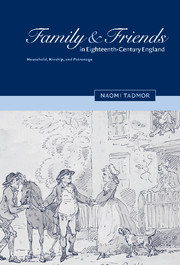Book contents
- Frontmatter
- Contents
- Acknowledgements
- A note on the text
- List of abbreviations
- Introduction
- 1 The concept of the household-family
- 2 The concept of the household-family in novels and conduct treatises
- 3 The concept of the lineage-family
- 4 The language of kinship
- 5 Friends
- 6 Political friends
- 7 Ideas about friendship and the constructions of friendship in literary texts
- Conclusion
- Bibliography
- Index
Conclusion
Published online by Cambridge University Press: 30 July 2009
- Frontmatter
- Contents
- Acknowledgements
- A note on the text
- List of abbreviations
- Introduction
- 1 The concept of the household-family
- 2 The concept of the household-family in novels and conduct treatises
- 3 The concept of the lineage-family
- 4 The language of kinship
- 5 Friends
- 6 Political friends
- 7 Ideas about friendship and the constructions of friendship in literary texts
- Conclusion
- Bibliography
- Index
Summary
This book has attempted to examine some historical concepts of the family. Central to the project has been the exploration of the household-family. When people in the eighteenth century spoke or wrote about ‘families’, they certainly could have had in mind groups of kin living together, or separately, as in present-day usages. They could also have had in mind significant notions of lineage and ancestry. But more often, what they had in mind was a household unit, which could comprise related and non-related dependants living together under the authority of a householder: it might include a spouse, children, other relations, servants and apprentices, boarders, sojourners, or only some of these. This concept of the family was thus flexible and permeable, for it could accommodate diverse family members and many changes over time. But as we have seen, ‘family’ units such as these also formed structured frameworks, with some well-understood roles and relationships. Important contractual relationships, occupational and instrumental relationships, affective relationships, and indeed kinship relationships existed within households, and these were also construed and represented in ‘familial’ terms. Accordingly, when people in the eighteenth century moved in and out of households (which they did often as servants, apprentices, spouses, wards, boarders, lodgers, or even long-term guests), their actions were often understood in terms of the household-family, its roles and relationships. Similarly, acts of transgression and defiance of authority could also be understood in terms of the structural and relational framework of the household-family.
- Type
- Chapter
- Information
- Family and Friends in Eighteenth-Century EnglandHousehold, Kinship and Patronage, pp. 272 - 279Publisher: Cambridge University PressPrint publication year: 2001

